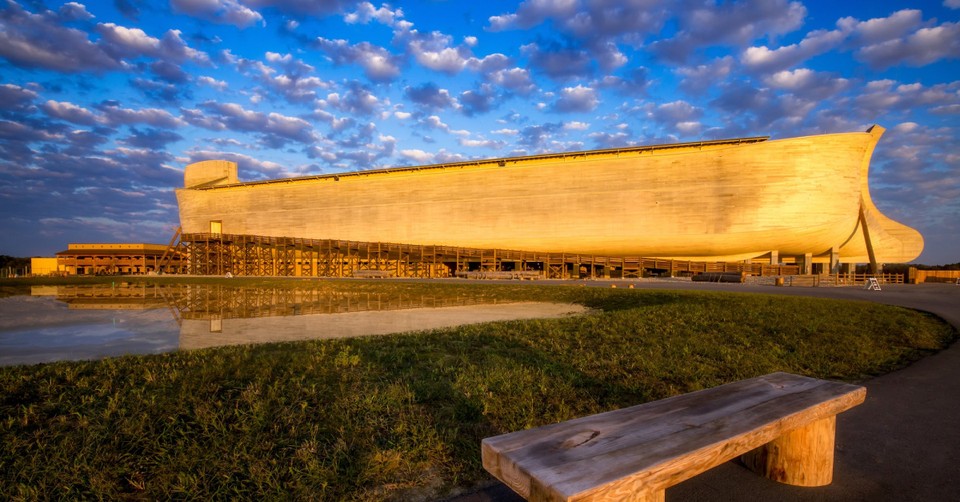Q&A: Noah, the Flood, and the Ark

The account of Noah and the Ark is one of the most widely known in the history of mankind. Unfortunately, like other Bible accounts, it is often taken as a mere fairy tale.
The Bible, though, is the true history book of the universe, and in that light, the most-asked questions about the Ark and the Flood of Noah can be answered with authority and confidence.
How Large Was Noah's Ark?
"The length of the ark shall be three hundred cubits, the breadth of it fifty cubits, and the height of it thirty cubits." (Genesis 6:15)
Unlike many whimsical drawings that depict the Ark as some kind of overgrown houseboat with giraffes sticking out the top, the Ark was a huge vessel. Not until the late 1800s was a ship built that exceeded the capacity of Noah's Ark.
Measuring by cubits1, we know that the Ark must have been at least 450 feet long, 75 feet wide, and 45 feet high. In most of the Western world, wooden sailing ships never got much longer than 330 feet, yet the ancient Greeks built vessels at least this size 2,000 years earlier. China built huge wooden ships in the 1400s that may have been as large as the Ark. The biblical Ark, about as large as a wooden ship can be, is one of the largest wooden ships of all time—a midsized cargo ship by today's standards.
How Could Noah Build the Ark?
The Bible does not tell us that Noah and his sons built the Ark by themselves. Noah could have hired skilled laborers, or relatives like Methuselah and Lamech might have helped. However, nothing indicates that they could not—or did not—build the Ark themselves in the time allotted. The physical strength and mental processes of men in Noah's day was at least as great as our own, and perhaps superior.2 They certainly possessed means for harvesting and cutting timber and for shaping, transporting, and erecting massive beams and boards.
If one or two men today can erect a large house in just twelve weeks, how much more could three or four men do in a few years?
Ancient technology should not be underestimated. Adam's descendants were making complex musical instruments, forging metal, and building cities—their tools, machines, and techniques were not "primitive."
Early post-Flood civilizations display the engineering know-how necessary for a project like Noah's Ark. People sawing and drilling wood in Noah's day, only a few centuries before the Egyptians were sawing and drilling granite, is very reasonable! The idea that older civilizations are more "primitive" is an evolutionary concept.
In reality, when God created Adam, he was perfect. The human intellect has suffered from 6,000 years of sin and decay. The sudden rise in technology in the last few centuries has nothing to do with increasing intelligence; it is a combination of publishing and sharing ideas and the spread of key tools for investigation and manufacturing. One of the most recent tools is the computer, which compensates a great deal for our natural decline in mental performance and discipline.
How Could Noah Fit All the Animals on the Ark?
In Noah's Ark: A Feasibility Study, creationist researcher John Woodmorappe generously suggests that, at most, 16,000 animals were needed to preserve the created "kinds." The Ark did not need to carry every kind of animal—nor did God command it to. It carried only air-breathing, land-dwelling animals such as creeping things and winged animals such as birds. Aquatic life and many amphibious creatures could have survived in sufficient numbers outside the Ark. This cuts down significantly the number of animals needed on board.
Another factor to consider is that today's tremendous variety in species did not exist in the days of Noah. Only the parent kinds were required to be on board in order to repopulate the earth.3 For example, only two dogs were needed to give rise to wolves, dingos—all the dog species we know today. Estimates for the maximum number of animals necessary on the Ark have ranged from a few thousand to 35,000, but they may be as few as two thousand if the biblical "kind" is approximately the same as the modern "family" classification.
It's also likely that Noah took only juveniles aboard the Ark to repopulate the earth. Younger animals require less space, food, and waste.
Using the conservative short cubit of 18 inches, Woodmorappe's conclusion is that "less than half of the cumulative area of the Ark's three decks need to have been occupied by the animals and their enclosures."4 This meant there was plenty of room for fresh food, water, and even many other people.
Where Did All the Water Come From?
"The same day were all the fountains of the great deep broken up, and the windows of heaven were opened. And the rain was upon the earth forty days and forty nights." (Genesis 7:11-12)
The Bible tells us that water came from two sources: below the earth and above the earth. Evidently, the source for water below the ground was subterranean, or "fountains" of water, which were broken open by volcanic and seismic activity.5
Where Did All the Water Go?
Simply put, the water from the Flood is in the oceans and seas now. Three-quarters of the earth's surface is covered with water.
Even secular geologists observe that the continents appear to have been at one time together and not separated by the vast oceans of today. The Flood was certainly sufficient to change all of this.
Scripture indicates that God formed the ocean basins, raising the land out of the water, so that the floodwaters returned to a safe place. (Psalm 104:6-9 likely refers to this event.) Some creation scientists believe this breakup of the continent was part of the mechanism that ultimately caused the Flood.6
Some have speculated, because of Genesis 10:25, that the continental break occurred during the time of Peleg. However, this division is mentioned in the context of the Tower of Babel's language division of the whole earth (Genesis 10-11). So the context points to a dividing of languages and people groups, not of the land breaking apart.
A massive movement of continents during the time of Peleg would have caused another worldwide flood. The Bible indicates that the mountains of Ararat existed (Genesis 8:4); so the Indian-Australian Plate and Eurasian Plate had to have already collided, indicating that the continents had already shifted prior to Peleg.
How Is Christ Like the Ark?
"For the Son of man is come to save that which was lost." (Matthew 18:11)
Jesus came to seek and save the lost. Just as Noah and his family were saved by the Ark, rescued by God from the floodwaters, so anyone who believes in Jesus as Lord and Savior will be spared from the coming final judgment of mankind, rescued by God from the fire that will destroy the earth after the last days (2 Peter 3:7).
Noah and his family had to go through a doorway into the Ark to be saved, and the Lord shut the door behind them (Genesis 7:16). So we too have to go through a "doorway" to be saved so we won't be eternally separated from God. The Son of God, Jesus, stepped into history to pay the penalty for our sin of rebellion. Jesus said, "I am the door: by me if any man enter in, he shall be saved, and shall go in and out, and find pasture" (John 10:9).
Footnotes
1The cubit was defined as the length of the forearm from elbow to fingertips. Ancient cubits vary anywhere from 17.5 inches to 22 inches, the longer sizes dominating the major ancient constructions. Despite this, even a conservative 18-inch cubit describes a sizeable vessel.
2See Dr. Donald Chittick, The Puzzle of Ancient Man, Creation Compass, Newberg, Oregon, 1998.
3More than 200 dog breeds exist today, all descended from one original dog "kind" (as have the wolf, dingo, etc.). Many other types of animals have been bred to achieve the wonderful variation in species that we have today. God programmed this variety into the genetic code of all animals—and even of humankind! God also made it impossible for the basic "kinds" of animals to breed. For example, cats and dogs cannot breed to make a new type of creature. This is by God's design, and it is one fact that makes evolution impossible.
4Woodmorappe, Noah's Ark: A Feasibility Study, Institute for Creation Research, Santee, California, 2003, 16.
5For deeper study on this, see Nozomi Osanai, A Comparison of Scientific Reliability, a comparative study of the flood accounts in the Gilgamesh Epic and Genesis, www.answersingenesis.org/go/gilgamesh.
6See chapter 14 by Dr. Andrew Snelling of The New Answers Book for more details.
Ken Ham is the president/CEO and founder of Answers in Genesis-U.S. and the highly acclaimed Creation Museum. A native Australian who now resides near Cincinnati, Ohio, he is one of the most in-demand Christian speakers in North America. He is the author of numerous books on Genesis, the accuracy and authority of the Bible, dinosaurs, and the destructive fruits of evolutionary thinking. Visit www.AnswersInGenesis.org for more information.
This article was originally published in Home School Enrichment Magazine.
Photo credit: ©Answers in Genesis
Originally published August 27, 2024.







